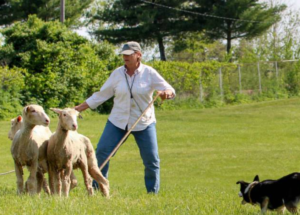In our blog series of Trial Tips from Top Hands, this one comes from Beverly Lambert, arguably one of the best, American handlers. Her multitude of achievements over the years includes winning the Meeker Classic, Soldier Hollow Classic, The Bluegrass Sheepdog trial, and reserve champion at the National Finals. These successes came on more than one occasion with several, different dogs. It is said that Bev can win with a poodle. No one would argue with that. Here’s what she has to say:

One of the trickiest pieces of advice I’ve been given on trial preparation was from Vergil Holland. Early (a really long time ago) in my career he told me “to prepare for the trial you are going to.” If you are running on wild sheep that have never seen a dog before try and prep for that. If the sheep are someone’s school sheep that get worked by dogs six hours a day prep for that. If the field is large and has a demanding outrun prepare for that and so forth.
Given that most of the preparation that we all do for dog trials is done on our regular practice/training sheep in the field we train in every day this preparation requires some creative thinking. The preparation for easy sheep is easily done on the most dog broke sheep you have available. Further than that this sort of preparation is not reliant on the type of sheep used but also on what you practice. When I know I’m going to a place with easy sheep I work on getting my dogs relaxed and very obedient. I work at hand and do a lot of driving, these are activities that get the dogs calm and confident.
The hard trials for me to prepare for are those that have sheep totally different from my training sheep. A good example of this kind of trial is Meeker or Soldier Hollow with their very tough un-dogged sheep. I know that as it heats up in the afternoon at Meeker the sheep become very reluctant to move. This is a situation where one of my dogs is likely to feel the need to go in and encourage forward momentum by physical means. I can’t change the basic nature of this dog but I can try and put her in this situation and discourage this specific behavior. I might drive a group of sheep into the corner of the fence and ask the dog to walk on when the sheep stop. I will do this at hand where I can keep control of the situation and then later at a distance.
This is a specific example of something I do with a particular dog for a specific trial. The trick is identifying the behavior that you can work on and coming up with an exercise that your training situation will allow you to use to address it.
Trial preparation is what we do after we have the dog fully trained and experienced in a variety of situations. This is the fancy stuff and as such it is more a test of the creative thinking of the handler than anything else.
Try and find something that you think might be or has been a problem. Then break it down into as specific a behavior as you are able. It’s no good saying I always miss the second drive gate. What is the specific action that could help you to get that gate? The easy part is usually fixing the problem the hard part can be figuring out what the problem is.
If you are missing drive gates see if your dog is tightening up when he receives multiple flank commands in a row. The first or second flank might be good the third one when you give that “Oh my God I’m missing the gate” command might be too tight. Is your dog going too far around the sheep on the flank or not far enough? Figure out the problem and then do some creative thinking.